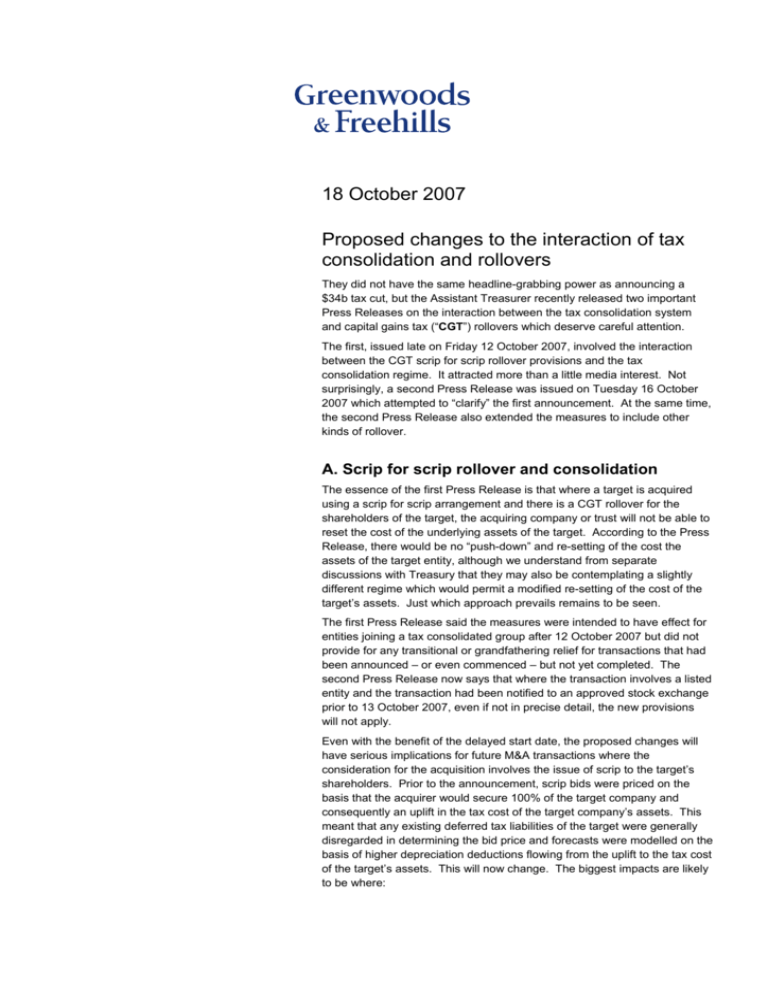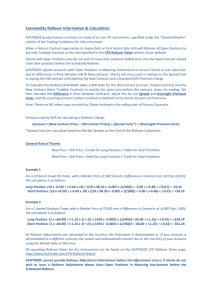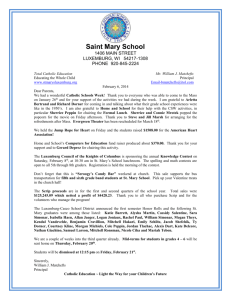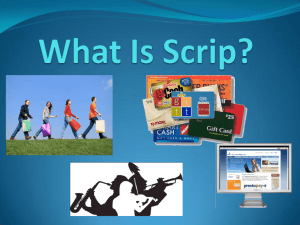Proposed changes to the interaction of tax consolidation and rollovers
advertisement

18 October 2007 Proposed changes to the interaction of tax consolidation and rollovers They did not have the same headline-grabbing power as announcing a $34b tax cut, but the Assistant Treasurer recently released two important Press Releases on the interaction between the tax consolidation system and capital gains tax (“CGT”) rollovers which deserve careful attention. The first, issued late on Friday 12 October 2007, involved the interaction between the CGT scrip for scrip rollover provisions and the tax consolidation regime. It attracted more than a little media interest. Not surprisingly, a second Press Release was issued on Tuesday 16 October 2007 which attempted to “clarify” the first announcement. At the same time, the second Press Release also extended the measures to include other kinds of rollover. A. Scrip for scrip rollover and consolidation The essence of the first Press Release is that where a target is acquired using a scrip for scrip arrangement and there is a CGT rollover for the shareholders of the target, the acquiring company or trust will not be able to reset the cost of the underlying assets of the target. According to the Press Release, there would be no “push-down” and re-setting of the cost the assets of the target entity, although we understand from separate discussions with Treasury that they may also be contemplating a slightly different regime which would permit a modified re-setting of the cost of the target’s assets. Just which approach prevails remains to be seen. The first Press Release said the measures were intended to have effect for entities joining a tax consolidated group after 12 October 2007 but did not provide for any transitional or grandfathering relief for transactions that had been announced – or even commenced – but not yet completed. The second Press Release now says that where the transaction involves a listed entity and the transaction had been notified to an approved stock exchange prior to 13 October 2007, even if not in precise detail, the new provisions will not apply. Even with the benefit of the delayed start date, the proposed changes will have serious implications for future M&A transactions where the consideration for the acquisition involves the issue of scrip to the target’s shareholders. Prior to the announcement, scrip bids were priced on the basis that the acquirer would secure 100% of the target company and consequently an uplift in the tax cost of the target company’s assets. This meant that any existing deferred tax liabilities of the target were generally disregarded in determining the bid price and forecasts were modelled on the basis of higher depreciation deductions flowing from the uplift to the tax cost of the target’s assets. This will now change. The biggest impacts are likely to be where: • an acquiring entity makes a scrip bid intending to break-up the target and divest unwanted assets; or • where the target has substantial depreciable assets. Such transactions are now likely to involve tax leakage and the pricing assumptions will have to change considerably. The effects of this proposal will now become another issue to investigate in any due diligence inquiry prior to an acquisition. The new regime will change the dynamics between making a cash bid and a scrip bid. In so far as the bid is cash, the acquiring group may enjoy a step-up in the cost of the target’s assets, and therefore be willing to offer a higher price, but sellers will not enjoy a CGT rollover; if the bid is scrip, there will apparently be no step-up in the tax cost of the target’s assets, and the price will be lower but the sellers will enjoy a rollover. Ultimately, the taxpayers hit hardest by the change could be ‘mum and dad’ investors who seem to value highly the deferral of any CGT liability under the scrip for scrip regime. The brevity of the announcement has left many questions unanswered. The approach in the first Press Release suggests that once the new rule is triggered, the tax cost of the underlying assets will simply be inherited by the acquirer (there will be no “push down” when consolidation occurs). An alternative approach which we understand Treasury is still contemplating – that the uplift which would ordinarily occur will be reduced by the amount of the capital gain sheltered by the rollover – seems fairer, but completely impractical. While no push down is inconsistent with the logic of consolidation, modifying the amount to be pushed down would pose an insuperable information-gathering problem for the acquiring group. In addition, there are other transactions where the impact of the proposal is uncertain: • scrip and cash bids (i.e. where only partial rollover relief is available); • staggered acquisitions (where the acquirer already has acquired a significant stake in the target and then makes a scrip offer – rollover relief is only available in respect of the second arrangement that increases the ownership percentage above 80%); • where rollover relief is not relevant to selling shareholders (for example, shareholders who hold their shares on revenue account, are nonresidents or have capital losses); • where the acquirer does not know whether and how many of the selling shareholders chose rollover relief (rollover relief is optional and there is currently no mechanism for companies to know which shareholders have elected to obtain rollover); • as the consolidation exit rules effectively “push-up” the tax base of the underlying assets to determine the cost of the shares of an exiting company, the subsequent sale of the target company will now trigger a capital gain where no economic gain arises (unless there are specific rules to retain the actual cost base of the shares). 2 B. Incorporation, share exchange and unit exchange rollovers The second Press Release took this idea further and announced that the tax cost setting process under consolidation will not give rise to an uplift of cost for the assets of a company or trust following other CGT rollovers, even rollovers where there is no cost base uplift! The limitation will also be triggered if: • an individual or trustee has transferred assets to a wholly-owned company and claimed a rollover, and the company then joins a consolidated group or MEC group; • partners have transferred partnership assets to a wholly-owned company and claimed a rollover, and the company then joins a consolidated group or MEC group; • a shareholder (along with other shareholders) transfers pre-CGT shares to a company in exchange for shares in it and claims a rollover, and the new company then joins a consolidated group or MEC group; or • a unit holder (along with other unit holders) transfers pre-CGT units to a company in exchange for shares in it and claims a rollover, and the new company then joins a consolidated group or MEC group. Under the first two rollovers on this list, there is no cost base uplift – either for the transferors or the company – where the individual, trustee or partners exchange post-CGT assets for shares in a wholly-owned company. It is, therefore, odd that these two rollovers are included in this list. Again, the brevity of the second Press Release leaves many questions unanswered. For example, it is not clear how soon after the events which benefited from the rollover occurred, the company must join a consolidated group or MEC group for cost push-down to be denied. And, as in the first announcement, it is not clear just how the information requirements of this proposal can be handled. At present, the consolidated group or MEC group would usually not know, and it would not be able to find out, whether any of the shareholders of the company now joining their group elected to obtain rollover in some prior transaction. C. Demergers The second Press Release makes special reference to demerger rollovers. It announces that, “the [new] measures will not apply to demergers unless that demerger happens as part of the arrangement that involves an entity joining a consolidated group or MEC group.” Again, it is not made clear just how close the link must be between the demerger and the demerged entity joining a group. 3 D. Why are these changes being made? Both Press Releases were unexpected in large part because the changes they propose are inconsistent with the logic of the consolidation regime. A principal function of consolidation is to reset the cost of assets – to attribute the group’s cost base for the target’s shares onto the target’s assets. This is not a peripheral outcome; it is central to achieving one of the Government’s stated goals from introducing tax consolidation in 2002 – to remove “the double taxation of gains which are taxed when [assets are] realised and taxed again on the disposal of the underlying equity.” The proposed measures overlook the fact that the scrip for scrip rollover and the other rollovers only defer the taxing point for the transferring shareholders until they sell their replacement shares. The deferral may not be very long. As John Ralph noted in his 1999 report, it is not unusual for the annual turnover of shares in a company listed on the ASX to exceed 50%. Moreover, not all shareholders benefit from CGT rollover. For example, shareholders who hold their shares as revenue assets (insurance companies and share traders) get no such relief. The announced measures effectively reinstate double taxation of gains. The rationale for these changes is at best obscure. Possible reasons might be that: • scrip consideration is not a ‘real cost’ of acquiring an entity. Yet it seems perfectly clear in an economic sense that scrip consideration is valuable consideration and represents a ‘real cost’ to the acquirer and its shareholders. The effect is no different to the acquirer raising new equity in cash and applying the funds to acquire the target. The nonrecognition of this cost seems inappropriate. There are of course other contexts in the Act where scrip consideration is recognised as the cost to a taxpayer of the asset it acquires, apparently without any quarrel; • if a selling shareholder obtains rollover relief, the acquirer should not receive a cost base uplift; somehow, this is a double benefit and perceived by Treasury to be just too generous. As noted earlier, the CGT rollover relief is only a deferral mechanism – eventually tax will be paid by the target’s former shareholders when the replacement shares are sold. Also, for the rollovers where an individual, trustee or partnership transfers post-CGT assets to a whollyowned company and claims a rollover, there is no cost-base step-up for the company. The company’s costs in the assets is inherited, and the transferor’s costs in the shares are retained; their costs are just located in different places. There is no double benefit here, and this argument does not provide a compelling reason to deny push down. In addition, there are already rules in the scrip for scrip rollover preventing an uplift in the cost base of the shares in the target where the entities are closely held; or • the cost to be pushed down onto assets should not be market value; it ought to be either an actual cost paid for the shares or an inherited cost arising under a rollover, but not a step-up cost. Yet this discrepancy – the shareholders obtain rollover relief and the 4 acquirer obtains a market value cost base in the shares it acquires – has been a deliberate feature of the scrip for scrip provisions for widelyheld companies since their introduction in 1999. It is not treated as an error or loophole in the scrip for scrip rules. But somehow this becomes a problem when that same number is now to be pushed down to the assets, instead of being retained as the cost of shares. Whether or not we have correctly divined Treasury’s underlying rationale, the principal difficulty with the measure lies in Treasury’s position that some change is needed as an “integrity” measure – which invariably means defeating a contrived scheme to avoid tax. There would not seem to be any real potential for contriving a rollover to access a cost base uplift where the two entities involved are widely held. Where entities are closely held such schemes might be possible, but there are already rules which will preclude the cost base uplift in closely held cases, and of course, there is always the general anti-avoidance rule. Treasury will consult with practitioners and business in relation to these measures. For further information, please contact: Sydney Richard Hendricks richard.hendricks@gf.com.au 61 2 9225 5971 Josh Cardwell josh.cardwell@gf.com.au 61 2 9225 5887 Melbourne Richard Buchanan richard.buchanan@gf.com.au 61 3 9288 1903 Toby Eggleston toby.eggleston@gf.com.au 61 3 9288 1903 5 www.gf.com.au These notes are in summary form designed to alert clients to tax developments of general interest. They are not comprehensive, they are not offered as advice and should not be used to formulate business or other fiscal decisions. Greenwoods & Freehills Pty Limited ABN 60 003 146 852 Level 39 MLC Centre Martin Place Sydney NSW 2000 Australia Facsimile (02) 9221 6516 Telephone (02) 9225 5955 Liability limited by a scheme approved under Professional Standards Legislation 6





